-
郑奕珂
普通类 -
- 支持
- 批判
- 提问
- 解释
- 补充
- 删除
-
-
修改主题:基于多模态数据的学生学习投入评价
基于多模态数据的学生学习投入评价:一项研究综述
Multimodal data as a means to evalution the learning engagement: A Systematic Review
关键词:多模态数据、学习投入(参与)
multimodal data learning engagement
学习投入(行为、认知、情感)
行为:参与、注意力、讨论
认知:知识建构
情感:积极、消极、困惑
知识追踪
为什么要用多模态数据:文本数据——模态数据丢失
测量多模态数据的主要方式:文本、图像(眼动)、心率——可解释性
以协作学习为主(个体为辅)——分析个体还是小组
要解决的问题:
1.生理学数据(多模态数据)为什么能支持学习投入的评测?
2.(情感、基于文本数据 、心率、 面部识别、 脑电、皮肤电)等心理、生理学数据理论依据是什么? (备注:眼动算不算生理学数据还待确定)
3.用多模态数据评测学习投入(学习现象)给我们带来了什么?
-
多模态教学对学生学业表现的影响(多模态学习投入评价)
多模态教学对学生学业表现的影响(综述)
The impact of multimodal teaching on students' academic performance: :A Systematic Review
一、引言
在引言部分,首先简要介绍研究的时代背景和意义,阐述多模态教学在提高学生综合能力方面的作用,并说明研究目的和意义。可以提出本研究的创新性和重要性(可以从新奇效应入手)
- 研究背景
在文献综述部分,系统梳理以往多模态教学的研究现状,包括以下几个方面:
- 多模态教学的概念和发展历程。(多模态:指使用多种不同的数据模态文本、图像、音频、视频来描述和表达信息)
多模态教学:使用多种不同的感官模式来传达信息或进行交流(听、视、触、嗅、味)
2.多模态教学的定义及其理论基础,以及相关的教学策略和教学方法(可以结合VR、AR等研究方面的论文)。
3.多模态教学对学生学业表现的影响,主要从学习动机、学习方法、学习成绩三方面来阐述。
(对研究现状进行批判性分析,指出已有研究的不足和需要进一步探索的问题)
- 研究方法
解释性范围审查方法。(文献分析法)
进行范围审查的目的是检查研究活动的程度、范围和性质,并确定进行全面系统审查的价值。通过总结和传播感兴趣的研究发现,可以在现有文献中确定研究差距。
范围审查的框架总共包括五个阶段:(1)确定研究问题;(2)识别相关文献;(3)文献选择;(4)制图数据;(5)整理、总结和报告结果。
- 研究问题
在研究问题和假设部分,需要明确本研究的研究问题和假设。
研究问题可以包括:
- 多模态教学是否能够显著提高学生的学习效果?其作用机制是什么?
- 研究假设可以包括:
- 多模态教学能够通过增强学生的学习体验、促进自主学习和提高学生的综合能力来提高学习动机和学习效果。
- 多模态教学的缺陷以及改进方法。
- 研究结果
总结多模态教学对学生学业表现的具体影响方面。
现有想法是在教学后运用多模态数据分析,分析学生的学习情况。目前有关多模态教学的论文很多都是从多模态数据分析的角度来写,所以现在想法是多模态数据分析在教学中的多种应用。
-
阅读笔记1
论文阅读笔记 2023.09.21
文献题目
Conceptions of the metaverse in higher education: A draw-a-picture analysis and surveys to investigate the perceptions of students with different motivation levels
高等教育中的元宇宙概念:绘制图画分析和调查,以调查不同动机水平的学生的看法
文献作者
Gwo-Jen Hwang ,Yun-Fang Tu , Hui-Chun Chu
(黄国仁,涂云芳,朱慧俊)e
期刊信息
Computers & Education 203 (2023) 104868
摘要
近年来,元宇宙在高等教育中的应用引起了众多教育工作者和研究人员的关注。它允许学生参与身临其境的体验式学习,并体验各种真实的人类互动模式。研究人员指出,虽然新兴技术的引入可能会带来新奇感,但它无法长期维持学生的学习。学习者的学习表现仍然取决于他们的学习动机。本研究旨在探讨不同动机水平的学生对高等教育中元宇宙的概念和看法(即成长心态、学习态度和自我效能感)。进行了画画分析和调查。结果表明,大多数学生认为,通过元宇宙,他们可以在任何地方学习未指定学科领域的知识,实现为实际应用而学习的想法。在动机水平较低的学生的绘画中,他们仍然在元宇宙学习环境中进行静态学习活动(即阅读/学习和寻找来源)。另一方面,动机水平高的学生专注于体验式学习、操作或实践(即动手练习/表演和观察/体验)。此外,与动机水平低的学生相比,动机水平高的学生通常表现出更好的成长心态、学习态度和自我效能感。这意味着学习动机可能是影响学生成长心态、学习态度和在元宇宙中学习的自我效能感的重要因素。这项研究的结果为未来的研究奠定了基础,并为理解高等教育中不同动机水平的学生对元宇宙的概念提供了初步证据。最后,基于分析结果,本研究对元宇宙中学生的学习方法提出了建议,为未来高等教育研究人员和教师设计相关活动提供参考。
关键词
教学/学习策略;改进课堂;教学 ;教学问题;互动学习环境;元宇宙
创新点
分析学生对元宇宙学习的观念和看法。
受试者是具有不同动机水平的大学生。
本研究采用了画画分析和调查。
大多数学生认为元宇宙会帮助他们更好地学习。
高动力学生有更好的成长心态、态度和自我效能感。
研究背景
与元宇宙相关的研究主要集中在其社会影响的潜力以及技术的发展和应用上,而学习者对元宇宙的感知却很少被调查。一些报告学习者接受或有意使用元宇宙的研究是通过要求他们对一组选定的问卷项目做出回应,而不是让他们充分表达他们的想法和信念。因此,开展一项研究,让学习者从不同的角度来表达他们在高等教育中使用元宇宙的观点,是很重要的。
研究人员尚未从不同的角度探讨学生对高等教育中元宇宙的概念,特别是具有不同学习动机水平的学生。因此,本研究采用绘画技术,探讨了高等教育中元宇宙学习动机水平不同的学生的概念。
研究方法
本研究采用绘图技术和调查的方法,对学生在课堂上学习和体验元宇宙后的概念进行分析。(1.绘图分析技术可以获取通过传统调查难以测量的信息;此外,它允许受试者使用词汇或文本描述来表达他们的观点和想法来突出绘画。2.绘画分析也可以用于理解学习者对将新技术整合到学习或工作中的想象)
研究目的
与元宇宙相关的研究主要集中在其社会影响的潜力以及技术的发展和应用上,而学习者对元宇宙的感知却很少被调查。一些报告学习者接受或有意使用元宇宙的研究是通过要求他们对一组选定的问卷项目做出回应,而不是让他们充分表达他们的想法和信念。因此,开展一项研究,让学习者从不同的角度来表达他们在高等教育中使用元宇宙的观点,是很重要的。
研究目标
- 探讨高等教育中不同动机水平的学生的概念,包括参与的参与者、地点、学科领域、技术、信息器具、对象、活动、情绪和态度,以及他们自发表达中最常提到的关键词。
(2)考察不同学习动机水平的学生的成长心态、学习态度和自我效能感。
研究过程
1.研究方法:绘图分析技术和调查法。
2.参与者:89名来自台湾北部一所大学的学生参加了元宇宙在教育项目中的应用,这是一个为期一天(即6小时)的项目,旨在向学生提供元宇宙的知识,并培养他们在教育环境中使用元宇宙的能力。由于其中两名学生没有完成课程,只从38名男生和49名女学生中收集了87名有效的调查和图纸,平均年龄为24.3岁。所有学生都有使用多媒体或技术(如YouTube视频、电子书、网站)学习的经验,并每天使用互联网;此外,他们在参与本研究之前没有沉浸式虚拟现实或元宇宙的经验。
3.设计:
(1)在活动前,进行学习动机调查,以了解学生对该活动的学习动机,并进行简短的课程指导。随后,进行了一场讲座,介绍元宇宙的符号和应用;随后,学生被邀请体验元宇宙系统,由元平台公司开发的元视野工作室;
(2)测量工具:包括项目前的学习动机调查(根据现成问卷设计),以及项目后对成长心态、学习态度和自我能力的调查。采用5分李克特量表,从1=非常不同意到5=非常一致。
(3)学生们被要求在一张A4纸上画一幅画,以展示他们对教育中的元宇宙的概念。为了帮助他们理解和思考教育中的元宇宙的概念,我们给出了一个提示:“请根据你的概念或感知,描绘一幅在元宇宙中的学习的图画。”此外,学生们还被要求写下两到五句话来描述他们的画。他们花了大约30个min来完成他们的图纸和调查。在89名学生中,有两名学生的画因为没有画画而无效。因此,在排除这两幅画后,收集了87张画。
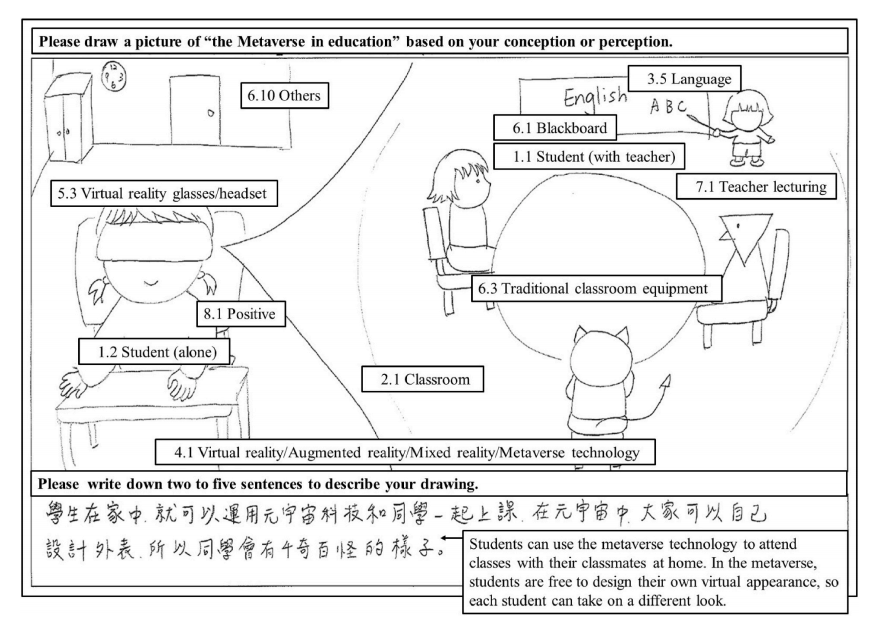
(4)为了通过画图技术探索高等教育中不同元宇宙动机水平的学生的概念,本研究参考了以往的研究,开发了一个编码方案来分析他们的绘画。
4.数据分析:包括学生绘画(即绘画和绘画描述)和调查(即学习动机、成长心态、学习态度和自我效能感),以比较不同学习动机水平的学生在项目前后的差异。
一个有高动机的学生的绘画表明,学习者可以使用VR眼镜进入元时代的体育场馆,与同龄人一起打排球。对于一个低动机的学生的绘画,除了V现实眼镜外,感官设备(即其他可穿戴设备)是相关学习或训练最常见的设备。
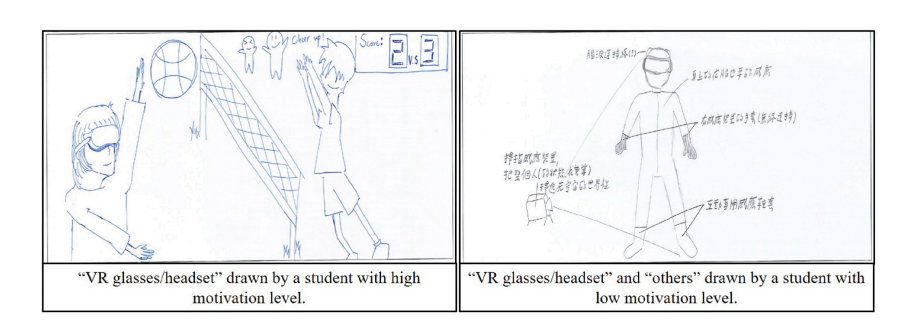
研究结果
大多数学生认为,在元宇宙中应用的技术(包括VR/AR/Mr//元宇宙技术、视频、人工智能、游戏和三维空间技术)允许他们在任何地点学习未指定的学科领域。学生们还考虑将元宇宙应用于各种课程,如科学和体育。在他们的绘画中,大多数学生表达了积极的情绪;他们认为,在元宇宙学习环境中,学习者可以与虚拟角色(如虚拟教师或虚拟患者)互动,并与同伴或教师一起学习。这表明,大多数学生认为,无论在何时和地点进行,学习都应该是互动的,例如,与学习环境、同伴、教师或虚拟人物进行学习
高动机水平的学生在成长心态、学习态度和自我效能感方面的平均得分高于低动机水平的学生。
具有高学习动机的学生通常可以创造学习热情和积极能量(即成长心态),培养积极的学习态度、参与度、自我效能感和学习成绩。
研究局限
首先,多元宇宙在教育项目中的应用只持续了一天,所有样本均来自台湾的同一所大学。因此,本研究的普遍性可能是有限的,结果可能只代表了台湾高等教育的部分学生。其次,本研究采用画图技术作为主要的数据收集工具,探索和比较在高等教育中具有不同动机水平的元宇宙的学生的概念。此外,研究人员还测量了他们的成长心态、学习态度和自我效能感。其他维度(例如,课堂参与度、流动体验、学习焦虑、认知负荷)尚未被调查。第三,本研究的结果是基于定量分析的。为了进一步探讨影响学生学习表现和认知的因素,未来的研究可以进行深入的访谈,探讨学生关注的高等教育中元时代的相关问题。目前的研究揭示了人们对患有不同程度的学生的看法
研究建议
由于本研究的实验持续时间较短,建议今后的研究应延长实验的持续时间,以探索和比较具有不同学习方式的学生的评价和学习结果。此外,还建议可以招募来自不同大学或不同教育水平的学生来调查与元宇宙学习环境相关的研究问题。
心得体会
该文主要是关于一项涉及参与者在各种不同学习风格下对元宇宙学习环境的反应和效果的研究。该研究通过对比实验结果,发现了一些有趣的见解。然而,由于实验时间较短,作者建议未来研究可以延长实验时间以更深入地探索和比较不同学习风格的学生所做的评论和学习成果。此外,还建议可以招募来自不同大学或不同教育水平的的学生来研究与元宇宙学习环境相关的研究问题。总的来说,文章提供了一个元宇宙学习环境对不同学习风格学生影响的研究框架和未来研究方向的启示。但作者在研究过程中对于影响因素的探讨太过于局限性,需要更多理论的支撑。
-
阅读笔记1(论文框架)
-
主题梗概
-
文献综述框架(网络学习资源的发展对学生学习动机的影响分析)
一、研究背景
随着信息技术的飞速发展,网络学习资源日益丰富,为学生提供了更多的学习机会和方式。然而,网络学习资源的发展也可能对学生的学习动机产生负面影响。因此,本文旨在探讨各类网络学习资源的发展对学生学习动机的影响,分析其作用机制和制约因素,并提出相应的建议和展望。二、综述原因
本文对相关文献进行综述的原因主要有以下几点:首先,了解网络学习资源的发展历程和现状,探究其对学生学习动机的影响机制;其次,分析网络学习资源的质量、互动性和个性化推荐等方面存在的问题与不足;最后,针对以上问题和不足,提出相应的建议和展望,为未来的研究提供参考。三、目的和意义
本文的目的和意义主要有以下几点:首先,深入了解网络学习资源的发展对学生学习动机的影响机制;其次,分析网络学习资源存在的问题与不足,为未来的研究提供参考;最后,针对以上问题和不足,提出相应的建议和展望,为教育工作者和政策制定者提供借鉴。四、学术背景和政策背景
学术背景
网络学习资源的发展历程可以分为三个阶段:Web 1.0阶段、Web 2.0阶段和Web 3.0阶段。Web 1.0阶段主要以静态网页为主,学生只能被动地接收信息。Web 2.0阶段出现了博客、社交网络等互动性较强的网站,学生可以在网络上主动参与学习和交流。Web 3.0阶段则以语义网为主,通过人工智能技术实现个性化推荐和学习。政策背景
五、研究现状
目前,关于网络学习资源的发展对学生学习动机的影响研究主要集中在以下几个方面:(1)网络学习资源的特点和优势
(2)网络学习资源对学生学习兴趣和积极性的影响
(3)网络学习资源对学生自主学习能力和创新意识的培养
(4)网络学习资源对学生学习负担和信息过载的影响
(5)网络学习资源对学生社交互动和情感体验的影响
六、主要的理论观点和技术
主要的理论观点包括:(1)网络学习资源的特点和优势可以激发学生的学习兴趣和积极性;
(2)网络学习资源可以提供更多的自主学习机会和创新空间;
(3)网络学习资源的质量、互动性和个性化推荐等方面存在问题与不足。
主要的技术包括:多媒体技术、虚拟实验室技术、个性化推荐技术等。
七、研究述评
八、指出存在的问题的方法和所需条件
九、预测今后发展方向
十、提出展望
-
阅读笔记2
论文阅读笔记 2023.10.12
文献题目
The effect of virtual reality learning on students' motivation: A scoping review
虚拟现实学习对学生学习动机的影响:一项研究综述
文献作者
Juming Jiang 1 | Luke K. Fryer2
期刊信息
Journal of Computer Assisted Learning
(Received: 17 January 2022, Revised: 7 September 2023, Accepted: 24 September 2023 DOI: 10.1111/jcal.12885)
关键词
motivation, novelty effect, virtual reality learning(动机,新奇效应,虚拟现实学习)
创新点
许多研究调查了虚拟现实学习对学生教育技术成果的影响。关于在复杂和多方面的在线虚拟现实环境中有效调整相关学习和动机理论以设计可持续教学的研究仍然相对缺乏。因此,本研究着重于探讨虚拟现实的新奇效应如何被有效克服(动机理论如何用于指导设计虚拟现实应用程序的过程,和/或将虚拟现实整合到学习活动中的过程)
研究背景
新冠肺炎疫情极大地影响了教育,需要传统面授教学的替代方法。这一巨大变化,加上人们对元宇宙人类可以在其中学习、工作和社交的虚拟现实(VR)世界——的认识不断提高,显然需要更好地理解基于VR的模拟环境对学生学习成果的潜在贡献。
研究方法
解释性范围审查方法
研究目的
解答三个关于虚拟现实体验对学生学习动机影响的研究问题:
RQ1.在虚拟现实学习中,有哪些方法可以排除新奇效应?RQ2.有哪些动机理论被应用于指导VR学习内容的开发?RQ3.有哪些动机理论被用来指导虚拟现实在学习活动中的应用?
研究目标
1.探讨高等教育中不同动机水平的学生的概念,包括参与的参与者、地点、学科领域、技术、信息器具、对象、活动、情绪和态度,以及他们自发表达中最常提到的关键词。
2.考察不同学习动机水平的学生的成长心态、学习态度和自我效能感。
研究过程
根据阿克西和欧玛利(2005)描述的框架,本文献综述选择了解释性范围审查方法。进行范围审查的目的是检查研究活动的程度、范围和性质,并确定进行全面系统审查的价值。通过总结和传播感兴趣的研究发现,可以在现有文献中确定研究差距。总共包括五个阶段:(1)确定研究问题;(2)识别相关文献;(3)文献选择;(4)制图数据;以及(5)整理、总结和报告结果。
研究结果
大多数纳入的研究表明,学生的动机在虚拟现实干预后有所增加或高于其他教学条件。然而,纵向研究设计的缺乏意味着不能排除VR学习中的新奇效应。讨论了研究设计和理论框架中的知识差距。
以往关于虚拟现实学习如何以及为什么提高学生学习动机的研究:(1)缺乏真正的纵向研究;(2)缺乏理论框架指导。
大多数研究在开发虚拟现实学习内容时没有考虑动机理论,而是倾向于依靠虚拟现实的沉浸式特征来激励学生。
研究局限
由于文章搜索和选择策略的标准,本综述不够全面。
1.具体来说,将文章的发表年份限制在2016年之后,这一年是Oculus Rift和HTC Vive等最受欢迎和最实惠的VR设备发布的一年。从那以后,虚拟现实学习研究变得相对容易进行。然而,虚拟现实在教育中的应用比那要早得多。2.我们将文章限制为同行评审的期刊文章,只是为了确保纳入文章的质量。如果仔细选择,会议记录和论文也可以提供有意义的证据。像Springer和ERIC这样的数据库也应该用来搜索文章。关于这一主题的未来审查可以扩大纳入标准的范围,以提供本研究中讨论的问题的更广泛的图片
研究建议
1.未来的研究希望表明动机的增加不是由技术的新颖性引起的,测量干预后参与者对技术新颖性(即虚拟现实)的感知,那么在需要分析数据时控制新颖性对动机的影响。
2.提高学生虚拟现实学习动机的两种方案:
(1)首先,创造满足学生基本心理需求的学习内容,从而提高学习活动的内在动机。具体而言,可以通过插入有意义的选择来满足自主的需要;对能力的需求可以通过即时反馈或与努力相关的表扬来满足;关联性的需要可以通过与智能教学代理或虚拟世界中其他学生化身的社会互动来满足。
(2)考虑到创建学习内容对于未经培训的教师来说也可能是困难的,以支持自主的风格呈现虚拟现实学习材料,教师例如不使用控制词,提供虚拟现实学习的选择和基本原理,等等。(教师可以创造有利于理解的环境,如基于项目的学习、合作小组工作和一对一的辅导)
心得体会
文章立足于VR技术对学生的学习动机影响,不同于以往肯定虚拟现实对学习动机的肯定作用,提出新奇效应对学习动机的影响,目前对于这一方面的研究还比较欠缺,可以从这方面入手进行研究。
-
阅读笔记3
论文阅读笔记 2023.10.14
文献题目
A review on data fusion in multimodal learning analytics and educational data mining
多模态学习分析与教育数据挖掘中的数据融合研究进展
文献作者
Wilson Chango1 | Juan A. Lara2 | Rebeca Cerezo3 | Cristobal Romero4
期刊信息
WIREs Data Mining and Knowledge Discovery(Received: 1 February 2022 Revised: 12 March 2022 Accepted: 15 March 2022 DOI: 10.1002/widm.1458)
关键词
data fusion, educational data science, multimodal learning, smart learning(数据融合,教育数据科学,多模态学习,智能学习)
阅读收获
- 多模态学习分析multimodal learning analytics (MLA):这种方法基于捕获、整合和分析不同来源的教育数据,这些数据共同提供了对学习过程的整体理解。在教育环境中的多模态交互过程中,新的数据收集和传感技术使得获取大量关于学生活动的数据成为可能。这些技术包括计算机活动的记录、可穿戴相机、可穿戴传感器、生物传感器(例如,允许测量皮肤电导率、心跳和脑电图)、手势传感、红外成像和眼睛跟踪。
- 教育数据挖掘(EDM)Educational data mining (EDM):将数据挖掘(DM)技术应用于来自教育环境的特定类型的数据集,以解决重要的教育问题。
- 学习分析(LA)Learning analytics (LA):可以定义为测量、收集、分析和报告关于学习者及其背景的数据,目的是理解和优化学习及其发生的环境。
心得体会
多模态指从混合的多个评价指标中获取数据。
多模态教学指使用多种不同的数据模态(文本、图像、音效、视频)、不同的感官模式(触、听、视、嗅、味)来描述和表达信息。
-
阅读笔记4
论文阅读笔记 2023.10.21
文献题目
基于多模态数据的大学生认知深度评价框架构建及应用
文献作者
范福兰1,李韩婷1,戚天姣2,梅 林3,雷雪英1
期刊信息
范福兰,李韩婷,戚天姣等.基于多模态数据的大学生认知深度评价框架构建及应用[J].现代远距离教育,2023(03):57-65.DOI:10.13927/j.cnki.yuan.20230630.001.
摘要
提高学生课堂认知深度是本科教育高质量发展的核心目标,如何对认知深度展开科学评价是关乎此目标达成的关键,也是深化本科课程教学改革的迫切需求。 为此,首先基于经典认知深度评价理论,结合新兴多模态数据分析技术,搭建大学生认知深度多模态评价框架。其次,基于此框架开展实证研究:以 Z 高校教育技术专业课程“ 学习科学与技术” 为例,通过智能录播系统、在线学习平台等工具从多维学习空间采集主题讨论、自我反思、 思维导图、课堂问答、头部姿势等多模态学习数据,采用机器学习方法处理并分析学习数据,综合评价学生认知深度并进行反馈。 结果显示,多模态数据支持的评价更能准确地反映学生认知深度,具有显著的以评促学效能,最佳数据源是自我反思、思维导图和课堂问答。
关键词
认知深度;多模态数据;学习评价
研究目的
- 着重解决如何在常态化教学环境中动态 捕获并分析学习过程中的多模态数据的问题,继而开展大学生认知深度评价。
研究背景
当前认知深度评价以问卷调查和测试等 方式为主,形成的数据模态较为单一,存在评价结果 准确性不高等问题。 多模态数据支持的学习评价具 有动态性、空间多维性、高准确性,为认知深度评价提 供了 新 思 路, 但 存 在 忽 视 线 下 学 习 数 据 的 采 集 与 挖 掘、对学习空间和采集设备要求较高等问题,在常态 化教学中运用受限。 如何在常态化教学环境中动态 捕获并分析学习过程中的多模态数据,继而开展大学 生认知深度评价,是当前亟需解决的问题。
研究方法
- 基于经典认知深度评价理论,结合新兴多模态数据分析技术,搭建大学生认知深度多模态评价框架。
- 基于此框架开展实证研究:以 Z 高校教育技术专业 课程“ 学习科学与技术” 为例,通过智能录播系统、在线学习平台等工具从多维学习空间采集主题讨论、自我反思、 思维导图、课堂问答、头部姿势等多模态学习数据,
- 采用机器学习方法处理并分析学习数据,综合评价学生认知深 度并进行反馈。
研究目标
在经典认知深度评价理论的基础上,搭建基于多模态数据技术的大学生认知深度评价框架,并将其应 用到本科课堂认知深度评价研究中,通过采集、处理 与分析学习过程中的多模态数据,探明大学生认知深 度多模态评价路径及评价框架的运用效果。 以此,可 为教师及研究者开展大学生学习评价改革、充分发挥 评价对学习的促进作用提供借鉴与参考。
研究过程
- 构建评价框架:充分考虑日常教学中可利用的智能感知设备及便于采集的学习数据类型,构建常态化教学环境下基于多模态数据的大学生认知深度评价框架。
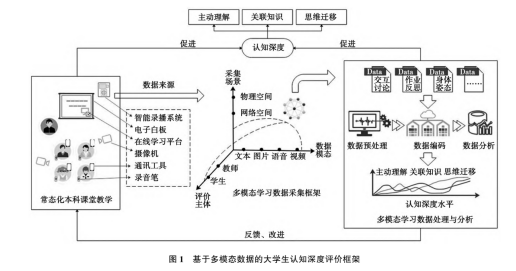
- 评价框架结构解析:
- 认知深度粒度解析
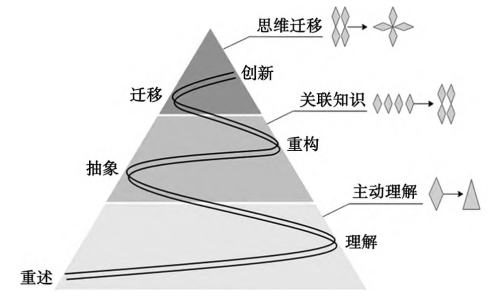
(认知深度评价三维度模型)
- 多模态数据类型及其表征
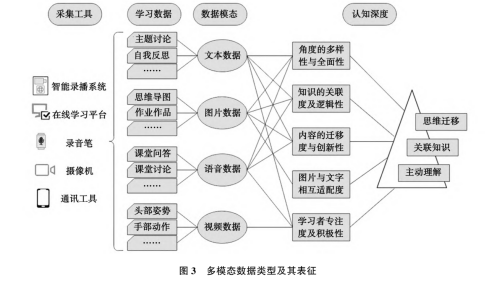
- 多模态数据处理与分析
数据预处理、数据编码与挖掘、数据分析与呈现
- 实践
实践被试:武汉市 Z 高校 2020—2021 学年第二学期教育 技术专业课程期末考试平均成绩为检验数据,进行独 立样本 t 检验,选取成绩不存在显著差异且人数相同 (36 人)的两个本科班级的学生参加本次实验,将 A 班作为实验组,将 B 班作为对照组。
自变量:认知深度评价实施策略
因变量:学习成效(课程实践成绩、综合表现成绩和期末测试成绩)
无关变量:授课教师、 教学内 容 及 教 学 过 程 等
实验过程:数据采集(智能录播系统)——数据处理与编码
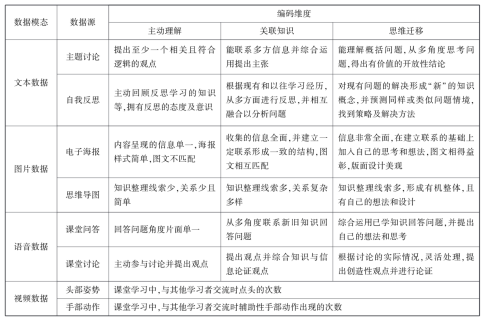
研究结果
框架应用效果:
- 采用线性回归、K 近邻回归、岭回归、决策树等九 种回归分析算法,检测多模态数据和单模态数据对学 业成效的预测情况,基于多模态数据的评价框架能更准确评价 大学生认知深度水平。
- 将大学生混合式学习评 价框架的线下学习数据、线上学习数据和学习绩效三 个维度的综合分数作为衡量学业成效的指标,将实验 组和对照组的分数进行独立样本 t 检验,基于多模态数据的大学生认知深度评价框 架具有显著的以评促学效能。
- 采用极端随机森林、决策树、随机森林等回 归算法,评估多模态学习数据各项数据源对认知深度 的评价性能,大学生认知深度评价的最佳数据源是自我 反思、思维导图和课堂问答。
研究局限
由于研究样本较小,导致无法使用精度更高的深度学习方法。
研究建议
研究将以认知深度理论为指导, 关注多模态数据挖掘技术与特征提取方法,进一步探 索深度学习中的小样本学习方法,深入研究基于多模 态数据的大学生认知深度评价框架与体系,更为全面 精准地评价学生认知深度。
心得体会
这篇文章主要研究目的是为了提高学生课堂认知深度,探讨了多模态数据在认知深度评价中的应用。通过结合经典认知深度评价理论和新兴多模态数据分析技术,建立了大学生认知深度多模态评价框架。该框架可以综合评价学生的认知深度,并为其提供反馈。实证研究以“学习科学与技术”课程为例,采集了多模态学习数据,包括主题讨论、自我反思、思维导图、课堂问答和头部姿势等,并采用机器学习方法处理和分析数据。结果显示,多模态数据支持的评价更能准确地反映学生认知深度,具有显著的以评促学效能。因此,多模态评价可以成为深化本科课程教学改革的工具,促进学生的认知深度发展。
-
阅读笔记5
论文阅读笔记 2023.11.01
文献题目
Multimodal data as a means to understand the learning experience
文献作者
Michail N. Giannakosa,, Kshitij Sharmaa, Ilias O. Pappasa,c, Vassilis Kostakosb, Eduardo Vellosob
期刊信息
Giannakos等, 《Multimodal Data as a Means to Understand the Learning Experience》.
International Journal of Information Management 48 (2019) 108–119.
摘要
摘要:Most work in the design of learning technology uses click-streams as their primary data source for modelling & predicting learning behaviour. In this paper we set out to quantify what, if any, advantages do physiological sensing techniques provide for the design of learning technologies. (what:量化生理传感技术为学习设计提供了哪些优势?)We conducted a lab study with 251 game sessions and 17 users focusing on skill development (i.e., user"s ability to master complex tasks). We collected click-stream data, as well as eye-tracking, electroencephalography (EEG), video, and wristband data during the experiment. (how:收集的生理传感技术数据种类)Our analysis shows that traditional click-stream models achieve 39% error rate in predicting learning performance (and 18% when we perform feature selection), while for fused multimodal the error drops up to 6%. (result:融合的多模态使得点击流模型在预测学业表现时,错误率从39%降到6%)Our work highlights the limitations of standalone click-stream models, and quantifies the expected benefits of using a variety of multimodal data coming from physiological sensing. (强调独立点击流模型的局限性,并量化了使用来自生理传感的各种多模态数据的预期好处。)Our findings help shape the future of learning technology research by pointing out the substantial benefits of physiological sensing.
关键词
Human learning, Multimodal learning analytics ,User-generated data Skill acquisition ,Multimodal data ,Machine learning
研究贡献
- present insights from a controlled experiment that collected five different data-streams during a basic user/learner–computer interaction task. (在完成任务过程中收集五种不同的数据流)
- We show that multimodal data-streams have the capacity to give more accurate prediction of users’ skills acquisition compared to traditional click-stream models. (多模态数据流能够更准确地预测用户的技能获取情况)
(3)We identify the physiological features that best predict skill development. (确定生理特征最能预测技能发展)
(4) We discuss how our findings can be used to design future learning technologies, as well as to advance research in the area of learning technologies.”(讨论用研究成果来设计未来学习技术) (Giannakos 等, 2019, p. 109)
研究目的
s paper builds on prior work on MultiModal Learning Analytics (MMLA) and attempts to shed light on the capacity of learnergenerated data, beyond clickstreams, to explain learning.” (Giannakos 等, 2019, p. 109)
“Typical examples of such multimodal data (or MultiModal Learning Analytics – MMLA, as literature refers to them) include audio, video, electrodermal activity data, eye-tracking, user logs and click-stream data to name a few (Blikstein and Worsley, 2016; Prieto et al., 2018).” (Giannakos 等, 2019, p. 109)
试验方法
developed a time-tested game that has been used to measure specific skills (motor skills) in the past (Nicolson and Fawcett, 2000). Thus, we developed a Pac-Man game following all the game play elements and giving 3 lives for each session (see Fig. 1). The game was controlled by the 4 arrow buttons of the keyboard and was developed to log every keystroke of the user. The difficulty of the game increased from one session to another.(Giannakos 等, 2019, p. 111)

被试
“We recruited a total of 17 healthy participants (7 females) aged between 17 and 49 years (mean = 32.05, SD = 8.84). Participants were recruited from the participant pool of a major European university. Participants were familiar with the game, but none of them had played the game in the previous 2 years. Prior to completing the tasks, participants were informed of the purpose and procedure of the experiment and of the harmlessness of the equipment. Participants were given a movie theater ticket upon completion of the study.” (Giannakos 等, 2019, p. 111)
试验过程
“The participant wore the wristband and EEG cap, and connected and then calibrated all the data collection devices (i.e., eye-tracker, wristband, EEG, cameras). (设备)The eye-tracking, EEG and the wristband data streams were calibrated using the standard practices. The eye-tracker was calibrated using a 5-point calibration process; the EEG data was calibrated using the ENOBIO EOG correction mechanism. The researcher explained the mechanisms of the game and the respective keystrokes, double checked the data collection devices, and exited the room. The participant had approximately 40 min to master the game and achieve a score that was as high as
Possible.”(Giannakos 等, 2019, p. 111)

设计流程:
“The research design of our study is a single-group time series design”
“Each participant played on average 16 game-sessions (SD = 7), until their allocated time ran out. Each game-session started with 3 lives and ended when the participant lost all the three lives. For each level in a game-session, the speed of the ghosts increased. Fig. 3 presents the protocol of our experiment. Each participant was shown a 5-s break before starting each session, then completed 2–3 min of game-play, and then had a 2–3s reflection period while looking at their game score (Fig. 4).” (Giannakos 等, 2019, p. 111)
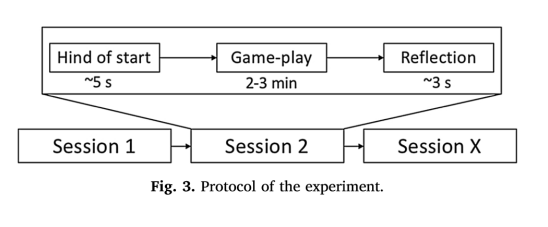
数据收集方法:
“we captured participants’ achieved score for each game session. In addition, we collected sensor data from five different sources: keystrokes (representing click-stream data), eye-tracking, EEG, video, and wristband (with sensors for heart-rate, blood-pressure, temperature and electrodermal activity levels).” (Giannakos 等, 2019, p. 112)
“Video – Given the fact that we expected participants to exhibit minimal body and gesture information during the study, video recording focused on their face. We use a Logitech Web cam capturing video at 30 FPS. The webcam focus was zoomed 150% onto the faces of participants. The video resolution was 640 × 480.” (Giannakos 等, 2019, p. 112) 视频——鉴于我们期望参与者在研究过程中展示最少的身体和手势信息,视频记录集中在他们的脸上。我们使用罗技网络摄像头以每秒30帧的速度捕捉视频。网络摄像头的焦点被放大150%到参与者的脸上。视频分辨率为640 × 480。
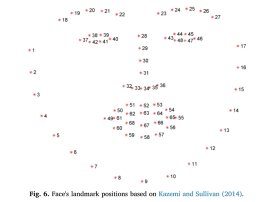
研究结果
in the face-video data-stream we identified important features that relate to jawline measures, mouth opening, and eyes opening. These features relate to affective states. In affective computing, and in particular affective learning technologies (Kapoor and Picard, 2005; Whitehill et al., 2014), these states have been used to create affective instructional strategies (Bosch et al., 2015). Such strategies can offer valuable information in advancing learning technologies (Bosch et al., 2015; Wiggins et al., 2015; Rana and Dwivedi, 2017), such as providing information that a user is engaged or delighted with the current task.” (Giannakos 等, 2019, p. 116)
“Wristband – To record arousal data we use the Empatica E4 wristband. Participants wore the wristband on the non-dominant/nonplaying hand. Four different measurements were recorded: (1) heart rate at 1 Hz, (2) electrodermal activity (EDA) at 64 Hz, (3) body temperature at 4 Hz, and (4) blood volume pulse at 4 Hz.” (Giannakos 等, 2019, p. 112) 腕带——为了记录唤醒数据,我们使用Empatica E4腕带。参与者将腕带戴在非惯用/非游戏手上。记录了四种不同的测量:(1)1 Hz的心率,(2)64 Hz的皮肤电活动(EDA),(3)4 Hz的体温,和(4)4 Hz的血容量脉搏。
结果:in the wristband data-stream, the important features are mean and SD for heart rate, electrodermal activity, body temperature and blood pressure. These are features associated with users’ affective states (Slovák et al., 2014; Hassib et al., 2016). Given that the core idea is to utilize multimodal data to enhance the learning experience, one promising strategy is to identify and minimize negative affective states (e.g. frustration, confusion, boredom) through a learning technology that has the capacity to utilize learner's affective state. Our findings quantify how much benefit we can expect to gain by incorporating such measures in the design of learning systems.” (Giannakos 等, 2019, p. 116)
最终实验结果:he performance with modality fusion from eye-tracking, EEG and Video gives the optimal prediction with an error of 6% (i.e., NRMSE 0.06).” (Giannakos 等, 2019, p. 114)
“To identify if the optimal prediction is significantly greater than any other combination, we used analysis of variances (ANOVA) to test it against the second best (i.e., eye-tracking) and found a significant difference (F[1, 32] = 9.26, p < 0.05).” (Giannakos 等, 2019, p. 114) 为了确定最佳预测是否显著大于任何其他组合,我们使用方差分析(ANOVA)将其与第二最佳预测(即眼球追踪)进行了测试,并发现了显著差异(F[1,32]=9.26,p<0.05)。

可以多方结合降低错误率并且也可以降低成本:aking into consideration both the technical difficulty and the high cost for the EEG and eye-tracking data collection, it is understandable why many studies in learning technology shy away from them. Nevertheless, researchers do not need to invest in expensive equipment and procedures to improve their models. Our results show that by simply combining data from the web camera and keystrokes can lead to an improved error rate (i.e., 15% error). Additionally, if a physiological wristband is available, then combining the web-camera with a wristband device like Empatica can reduce the error to 12%. While these approaches we recommend here may not achieve the optimal error rate of 6%, they are significantly convenient from a technical standpoint and do improve performance.” (Giannakos 等, 2019, p. 114) 。
研究局限
findings speak in favor of collecting eye-tracking and EEG data to predict learner performance (in our case skill development), but are subject to certain limitations. Our study participants – undergraduate and graduate students – represent an appropriate sample for a study on learning technologies (covering the higher education population), but are less representative of the population of K-12 schools (e.g., classroom learning), lifelong learning and learning in workplace who rely heavily on learning systems as well. Moreover, the study was performed in a controlled environment, which may have induced demand characteristics that affect the ecology of the study (e.g., participants’ performance and behavior). Specifically, participants were aware of the multimodal data collection since they signed a detailed consent form, which may have led to increased apprehension and desire “to perform”. Nonetheless, the population represents a large part of the learning technology end-users and the data collections are of very high quality and accuracy utilizing state of the art equipment.” (Giannakos 等, 2019, p. 116)
心得体会
研究介绍了多模态数据在理解学习体验中的应用,包括机器学习和人类学习的融合。文章指出,多模态数据可以提供更全面的学习体验信息,包括用户生成的数据和技能获取情况。通过对这些数据的分析,可以更好地理解学习过程和技能掌握情况,从而优化学习技术和提高学习效果。
文章中主要用了五种方式来测量多模态数据,并且在被试在玩吃豆人游戏的过程中对他们的生理数据进行测量,对于测量方式以及测量内容进行了比较详细的阐述,可以借鉴其中的video(面部追踪)和腕带部分的实验。
-
论文阅读6 2023/11/11
exploringstudents' cognitive and affective states during problem solvingthrough multimodal data: lessons learned from a programming activity
journalof computer assisted learning(ssciq1)
jcomput assist learn. 2022;38:40–59.)
katerinamangaroska1 | kshitij sharma1 | dragan gaševic 2 | michailgiannakos1
keywords:code-debuggingtask,cognitive-affectivestates, highereducation ,multimodaldata ,multimodallearning analytics
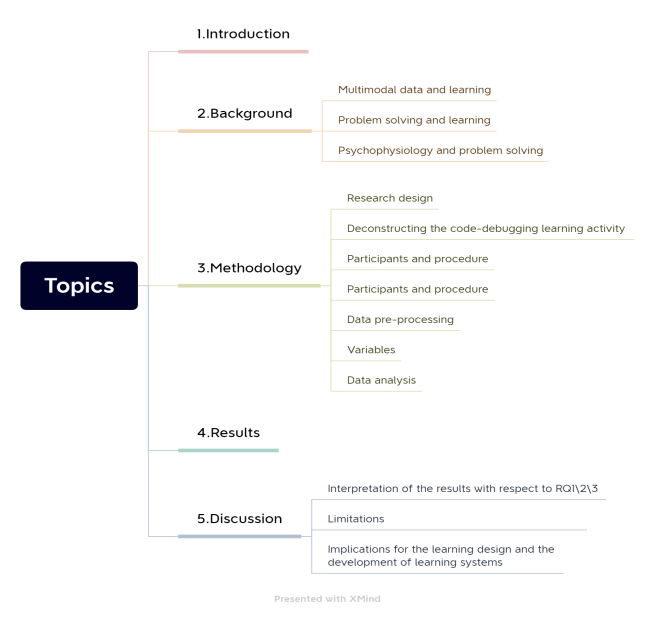
abstract
background(what?):problem-solving is a multidimensional and dynamic process thatrequires and interlinks cognitive, metacognitive, and affectivedimensions of learning. however,current approaches practiced in computing education research (cer)are not sufficient to capture information beyond the basicprogramming process data (i.e., ide-log data). therefore, howcognition and affect intertwine and unfold over time in programmingproblem-solving activities are rarely investigated.
objectives(why?)来自多模态数据的理论指导措施如何与学生表现相关联、与先验知识比较:in this study, we examined howthe theory-informed measures from multimodal datathat we have selected as proxies for cognitive and affectivedimensions of learning, areassociated with student performance, and in comparison, topriorknowledge.
methods(how?):a high-frequency temporal data was collected witha camera, an electroencephalogram, and an eye-trackerfrom 40computer science students(bachelor and master studies) in the context of a code-debuggingactivity. to study the cognitive processes associated with learningwe focused on cognitiveload theory (clt) and the human information processing model. inaddition, we complemented clt with themodel of affective dynamicsin learning to avoid the machine reductionism perspective.
results:our findings demonstrated thatattention, convergent thinking, and frustrationwere positivelycorrelated withstudents' successful code-debugging (i.e., performance), andfrequently manifested by highperforming participants.cognitiveload, memory load, and boredom werenegativelycorrelated with students'performance, and typically manifested by low performing participants.
implications(研究启示):extending the context of analysis in reference to student cognitiveprocesses and affective states, affords educators not just toidentify lower performers, but also to understandthe potential reasons behind their performance,making our method an important contribution in the confluence of cerand the learning technology communities. in addition, the insightsextracted from our analyses allow us todiscusspotential avenues for improving learning design and the design ofinteractive learning systems to support the development of students'problem-solving skills.
introduction
1.介绍选题原因(了解学生学习过程中行为活动的重要性)
thedifferent level of skills development, and the various cultural andpragmatic constraints, can cause some students to experience variouscognitive challenges and feelings of frustration, boredom, orconfusion with the learning content and the tasks, a behaviour thatcannot be easily noticed by the instructors in digital settings.
therefore,increasing our understanding howstudents' cognition, affect, and behaviour intertwine and spanthroughout the learning activities, can provide us with valuableinsights that can guide the learning design and the development ofnovel learning technologies.
2.介绍学习与多模态过程的相关性
learningis ultimately a complex, multimodal process that involves linguistic,gestural, visual, and physical interaction of students witheducational systems, learning artefacts, learning spaces, peers, andeducators
3.介绍研究过程中的理论依据
tostrengthen our understanding how cognition and affect co-exist insitu, and impact the performance of students, we have selected andexploredtheory-informedlearning constructs (e.g., expertise, convergent thinking)salient to problemsolving.
4.介绍本次的研究问题——what
(1) to what extent and how measures extracted from multimodal data thatactas proxies for cognitive and affective dimensions of learning areassociated with student performance?’
多模态数据的测量值与学生表现如何关联?怎么设置维度?
回答:thefindings from our experiment demonstrate that particularcognitive-affective states are relevant and influential to both, thecognitive process of problem solving and the performance of students.
(2) to what extentprior-knowledge isassociated with student performance in comparison to the measuresextracted from multimodal data?
测量先验知识与学生表现的关联性?
回答:expertiseis one of the factors that affect student performance. in fact,modern educational psychology research suggests that learningoutcomes result from the dynamic interaction of intra-individualfactors, such as prior knowledge, motivation, cognition, emotions,and the contexts surrounding learners (bronfenbrenner et al., 1998;national academies of sciences, 2018). therefore, wehave included expertise as one of the variables in our models toexplain the debugging performance.
(3)how measures from multimodal data can informand influence changes inthe learning design?
多模态数据如何影响(辅助)学习设计?
回答:weposit that confusion was demonstrated during the hypothesisverification stage when the students became metacognitively aware ofdiscrepant events, and a sign of progress for the high performingparticipants that managed the state of confusion productively.therefore, beingaware that some level of frustration and confusion are critical foroptimal learning.
特定的认知-情感状态对于学生的认知过程和表现都具有重要和影响。
从认知维度来看,实验证明了收敛思维和注意力在解决问题和学生学习时的积极作用。
定义了两种行为动作:阅读(r)和写作(w)事件,并且将这些动作映射回代码调试过程的三个阶段。
阅读事件包括学生阅读代码、输出或分配问题时的动作,而写作事件包括学生编辑代码以检查输出或问题时的动作。
情感维度(即喜悦、无聊、沮丧和困惑)与各种学习过程相关联。
5.介绍研究步骤——how three-fold
conceptual– to advance thediscussion on expanding the context and impact of learning analyticsresearch by posing new techniques (i.e., multimodal learninganalytics) that can inform and influence changes in the learningdesign;
提出概念(新技术——多模态学习分析)
operational– to deconstruct and investigate a problem-solving learningactivity at a fine level of details by utilizing multimodal learninganalytics;
利用新技术解析学习活动中的问题进行实验设计
empirical– to validate the benefits of augmenting (i.e., enriching)programming process data (i.e., ide-log data) with sensor data (e.g.,gaze data, facial expressions, eeg data) in the context of learningdesign.
实验证明
background
1.多模态数据与学习
multimodaldata can be collected in non-invasive ways using affordable sensortechnologies (e.g., eyetrackers, wristmounted devices, kinetic sensors,electroencephalograms)that monitor variations in different modalities (e.g., speaking,gesturing, gazing, typing) (lazar et al., 2017).
多模态数据收集方法
thework in this paper focuses on:
(1)measuresinformed by literature and grounded in theory,to minimize the risk of establishing weak concepts or missing toidentify other important patterns in the data;
(2)exploringproblem solving as a dynamic process andnot an outcome, by tracking clicks, actions, cognition, gaze, andfacial expressions from moment-to-moment.
2.问题解决与学习
problemsolving is adynamic process thatunfolds in different phases over time.
problemsolving is considered to be the bridge between learning andperformance , because it entailsmany behavioural and cognitive multi-step activities (governedby metacognitive awareness and emotions), that convert what islearned into behaviour and towards performance .
cognitiveload theory (clt)(认知负荷理论):
cognitiveload is not affected only by thecharacteristics of the task (i.e.,the learning design and the interface design), but also by thecharacteristics of the subject performing the task,and the interaction between the two.
themodel of affective dynamics(情感动力模型)
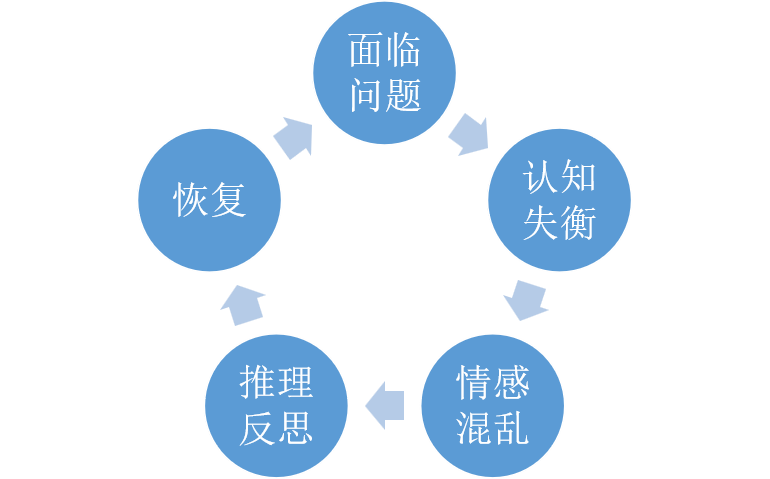
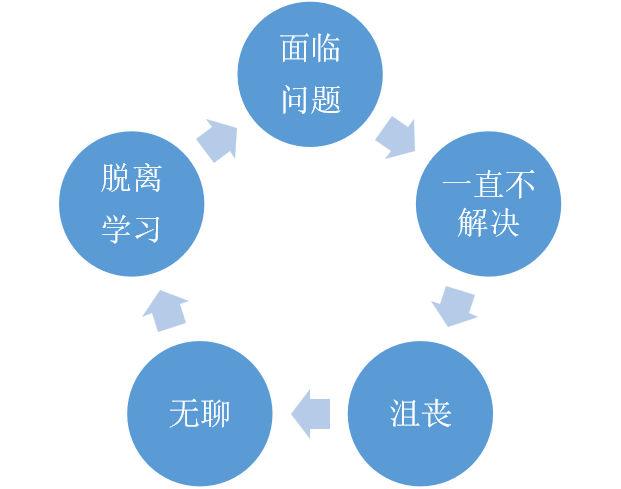
3.心理生理学与问题解决
positivefeedback triggers significantly faster decrease in thepupil diameter(瞳孔直径)(whichis a measure linked to cognitive load) than negative or neutralfeedback. such insights can lead towards the design of methods foremotions regulation in humans for e-learning.
allthese studies advance the current body of knowledge in the context ofproblem solving, by studying problem solving as a dynamicprocess of changeand by deriving insights obtained with sensor data, as data highlyrepresentative for the human affective and cognitive learningprocesses.
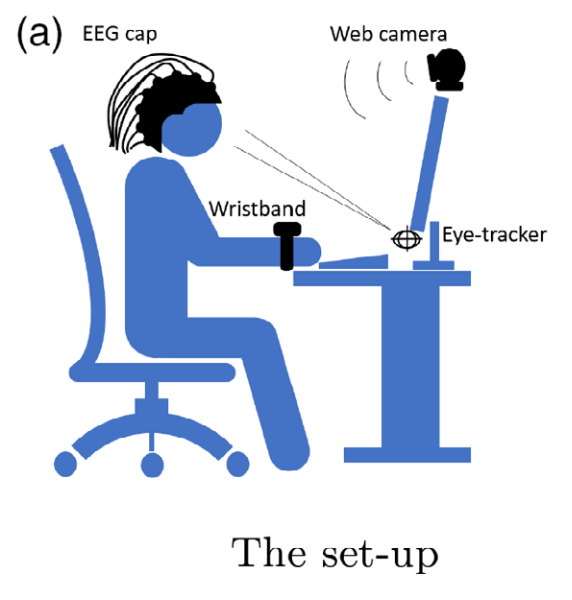

被试:
atthe norwegian university of science and technology (ntnu), with 46students(8 females and 38 males), age between 20 and 25.all recruitedstudents had used eclipse ide during their oop course.
theexperiment ran fora week - a total of 20 non-repeat sessions,where each session had two students at a time, on two separatecomputers.
工具:
(1)aneeg enobio cap
(2)theeye-trackers werecalibrated using a 5-point calibration process, while the eeg wascalibrated using the off-theshelf enobio eog correction software.
测试过程:
afterthe calibration process, the students were asked to finish threesmall code-debugging assignments (easy, medium, difficult) within 20min.(前测任务).
thestudents were given 40 min to solve the main task.(测试中)
研究局限:
作者承认了被试专业的一致性,这意味着这些发现可能不适用于其他专业的学生。这个问题解决任务是通过一个需要计算机科学领域特定知识的编程任务来探索的,而学习者的认知和情感状态在不同的领域中可能会有所不同。
学生们是单独进行这个活动的,这反映了一种特定的学习环境。这意味着这些结构的测量可能在协作学习的环境中会有所不同。
本研究主要依赖于计算机媒介的学习,学生们在整个过程中都使用计算机。未来,作者计划扩展到其他类型的学习环境,以更全面地了解学习者的认知和情感过程。
研究收获:
考虑学习者的认知和情感状态:学习设计和系统开发应该考虑到学习者的认知和情感状态,包括他们的注意力、记忆、思维等认知方面,以及他们的情绪、动机等情感方面。
提供个性化的学习体验:学习系统和应用程序应该能够根据学习者的认知和情感状态提供个性化的学习体验。
支持学习者对错误的处理:编程学习中经常会出现错误,学习系统和应用程序应该能够支持学习者对错误的处理。
促进协作学习:学习系统和应用程序应该能够促进学习者之间的协作学习。
整合多模态数据和学习分析:学习系统和应用程序应该能够整合多模态数据和学习分析,从而更好地理解学习者的认知和情感状态以及学习进展。
优点
结合理论进行实验设计,有非常扎实的理论依据
研究过程中考虑的因素很多,很全面
有很多图表,研究内容展示很清晰
缺点
研究过程的阐述有点混乱,有一些重复阐述的地方
被试者的局限比较大(都是计算机专业,可能会导致研究结果只适用于这一特定群体,而无法推广到其他领域或人群),试验周期比较短
-
论文阅读7 2023.11.17
认知与情感投入在学习中的应用——多模态方法论的视角
cognitiveand emotional engagement while learning with vr: theperspective of multimodal methodology
computers& education
摘要:
本研究采用多模态数据分析方法,以更连续和客观的方式了解学习过程中学生的投入情况及其对学习效果的影响。通过虚拟现实(vr)模拟学习环境,收集61名护理专业学生的学习过程数据,包括面部表情、眼动跟踪和电导汗液活动(eda)传感器等心理生理数据流,以及主观自我报告。通过对比学习前后的知识测试成绩评估学生的学习成果。回归分析表明,多个模态的数据解释了51%的后测知识成绩。具体而言,更高的先验知识和自我报告的热情,以及更低的愤怒情绪,对学习效果有积极影响。
关键词:虚拟现实;多模态方法;面部表情;眼动跟踪;学习投入;学习效果
引言:
认知投入是多维度的结构,是指学习者在学习时的积极参与,这种复杂的结构需要更加可视化和可计算。因此采用多模态的数据去研究。
随着技术的发展,虚拟现实(vr)已成为一种越来越受欢迎的学习工具。与传统的课堂教学相比,vr学习具有更多的优势,如可以提供更真实、更生动的学习体验,帮助学生更好地理解和掌握知识。然而,要使vr学习真正有效,需要了解学生在使用vr学习时的认知和情感投入情况。为此,本研究采用多模态数据分析方法,旨在更全面、更客观地了解学生在vr学习中的认知和情感投入情况及其对学习效果的影响。
实验设计:
研究对象为61名护理专业的学生,年龄在18-25岁之间。所有学生都使用相同的vr模拟学习环境进行学习。在学习过程中,学生的面部表情、眼动跟踪和电导汗液活动(eda)传感器等心理生理数据被记录下来,同时要求学生进行主观自我报告,以评估他们的情感投入情况。在学习前后,学生需要参加一个内容知识测试,以评估他们的学习效果。

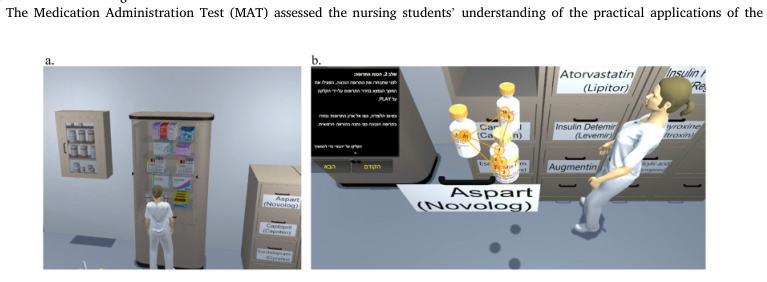
结果:
结果显示,学生在vr学习过程中的面部表情和主观报告都显示出较高的正面情感投入。其中,面部表情数据可以检测到学生在不同学习阶段投入度的波动。具体而言,学生在vr学习过程中的愤怒情绪较低,而喜悦、兴趣和专注等情绪较高。此外,眼动跟踪和电导汗液活动(eda)传感器等心理生理数据也表明学生在vr学习过程中投入了较高的认知和情感努力。
回归分析表明,多个模态的数据共同解释了51%的后测知识成绩。其中,先验知识、自我报告的热情和专注度对后测知识成绩有积极影响。而愤怒情绪则对后测知识成绩有负面影响。
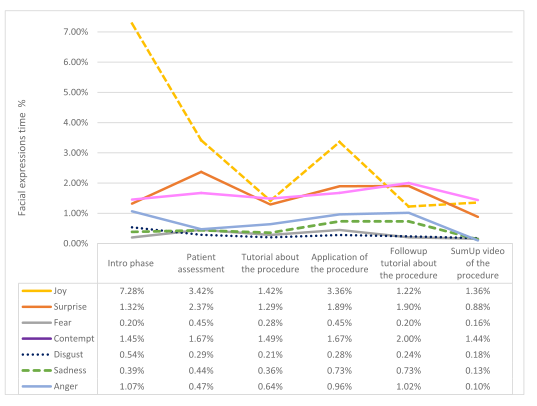

讨论:
本研究结果表明,学生在vr学习过程中的正面情感投入较高,并且这种投入对学习效果有积极影响。这可能是因为vr学习环境可以提供更真实、更生动的学习体验,从而激发学生的学习兴趣和动力。此外,面部表情数据可以有效地检测学生在不同学习阶段投入度的波动,从而为教师提供更及时、更准确的学生学习情况反馈。
结论:
本研究采用多模态数据分析方法,成功地探讨了学生在vr学习中的认知和情感投入情况及其对学习效果的影响。结果表明,学生在vr学习中的正面情感投入较高,并且这种投入对学习效果有积极影响。此外,面部表情数据可以有效地检测学生在不同学习阶段投入度的波动。因此,在实际教学中,教师可以通过观察学生的面部表情等心理生理指标来评估学生的学习情况,并及时调整教学策略以帮助学生更好地学习和理解知识。
-
-
- 标签:
- 多模态教学
- 学业表现
-
加入的知识群:

.jpg)

学习元评论 (0条)
聪明如你,不妨在这 发表你的看法与心得 ~